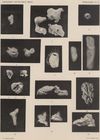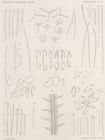WoRMS taxon details
Microxina benedeni (Topsent, 1901)
166764 (urn:lsid:marinespecies.org:taxname:166764)
accepted
Species
Gelliodes benedeni Topsent, 1901 · unaccepted (genus transfer)
Gellius benedeni (Topsent, 1901) · unaccepted (genus transfer)
- Variety Microxina benedeni var. fortior (Topsent, 1917) accepted as Gelliodes fortior Topsent, 1917 (reverted genus transfer and status change)
marine, brackish, fresh, terrestrial
recent only
(of Gelliodes benedeni Topsent, 1901) Topsent, E. (1901). Spongiaires. Résultats du voyage du S.Y. ‘Belgica'en 1897-99 sous le commandement de A. de Gerlache de Gomery. <em>Expédition antarctique belge. Zoologie.</em> 4: 1-54, pls I-VI.
page(s): 16 [details]
(of Gelliodes benedeni Topsent, 1901) Topsent, E. (1901). Notice préliminaire sur les éponges recueillies par l'Expédition Antarctique Belge. <em>Archives de Zoologie expérimentale et générale.</em> (3) 9 (Notes et Revue): v-xvi. (look up in IMIS)
page(s): VII [details]
page(s): 16 [details]
(of Gelliodes benedeni Topsent, 1901) Topsent, E. (1901). Notice préliminaire sur les éponges recueillies par l'Expédition Antarctique Belge. <em>Archives de Zoologie expérimentale et générale.</em> (3) 9 (Notes et Revue): v-xvi. (look up in IMIS)
page(s): VII [details]
Type locality contained in Amundsen/Bellingshausen Sea
type locality contained in Amundsen/Bellingshausen Sea [from synonym] [view taxon] [details]
Taxonomy In the opinion of Göcke & Janussen (2013: 80), the differentiation between the species M. benedeni and M. charcoti seems...
Taxonomy In the opinion of Göcke & Janussen (2013: 80), the differentiation between the species M. benedeni and M. charcoti seems distinct enough to consider them as different species. This raises the question, whether the assignment of G. benedeni to Microxina is legitimate. The great similarity between the species’ characters, as pointed out by Burton (1932), might speak for a close relationship between these species, thus justifying the assignment to Microxina, although on the other hand the species fits quite well with the definition of Gelliodes as given by Desqueyroux-Faúndez and Valentine (2002). A solution to this question can only be found through a close look at the holotype. Still, it must be mentioned that if this species is to be assigned to Microxina, the definition of this genus, as given in Desqueyroux-Faúndez and Valentine (2002), has to be emended in the way that not only microxea, but also sigmas are present in Microxina. [details]
de Voogd, N.J.; Alvarez, B.; Boury-Esnault, N.; Cárdenas, P.; Díaz, M.-C.; Dohrmann, M.; Downey, R.; Goodwin, C.; Hajdu, E.; Hooper, J.N.A.; Kelly, M.; Klautau, M.; Lim, S.C.; Manconi, R.; Morrow, C.; Pinheiro, U.; Pisera, A.B.; Ríos, P.; Rützler, K.; Schönberg, C.; Turner, T.; Vacelet, J.; van Soest, R.W.M.; Xavier, J. (2025). World Porifera Database. Microxina benedeni (Topsent, 1901). Accessed through: World Register of Marine Species at: https://www.marinespecies.org/aphia.php?p=taxdetails&id=166764 on 2025-04-05
Date
action
by
2005-07-10 18:05:41Z
created
db_admin
![]() The webpage text is licensed under a Creative Commons
Attribution 4.0 License
The webpage text is licensed under a Creative Commons
Attribution 4.0 License
Nomenclature
original description
(of Gelliodes benedeni Topsent, 1901) Topsent, E. (1901). Spongiaires. Résultats du voyage du S.Y. ‘Belgica'en 1897-99 sous le commandement de A. de Gerlache de Gomery. <em>Expédition antarctique belge. Zoologie.</em> 4: 1-54, pls I-VI.
page(s): 16 [details]
original description (of Gelliodes benedeni Topsent, 1901) Topsent, E. (1901). Notice préliminaire sur les éponges recueillies par l'Expédition Antarctique Belge. <em>Archives de Zoologie expérimentale et générale.</em> (3) 9 (Notes et Revue): v-xvi. (look up in IMIS)
page(s): VII [details]
page(s): 16 [details]
original description (of Gelliodes benedeni Topsent, 1901) Topsent, E. (1901). Notice préliminaire sur les éponges recueillies par l'Expédition Antarctique Belge. <em>Archives de Zoologie expérimentale et générale.</em> (3) 9 (Notes et Revue): v-xvi. (look up in IMIS)
page(s): VII [details]
Other
context source (Deepsea)
Intergovernmental Oceanographic Commission (IOC) of UNESCO. The Ocean Biogeographic Information System (OBIS), available online at http://www.iobis.org/ [details]
additional source Clarke, Andrew; Johnston, Nadine M. (2003). Antarctic marine benthic diversity. <em>Oceanography and Marine Biology: an Annual Review.</em> 41: 47-114. (look up in IMIS) [details] Available for editors [request]
[request]
additional source Burton, M. (1932). Sponges. <em>Discovery Reports.</em> 6: 237-392, pls 48-57.
page(s): 271-272 [details] Available for editors [request]
[request]
additional source Burton, M. (1934). Sponges. Pp. 1-58, pls I-VIII. <em>In: Further Zoological Results of the Swedish Antarctic Expedition 1901-03 under the Direction of Dr. Otto Nordenskjöld.</em> 3 (2). (Norstedt & Söner: Stockholm).
page(s): 11 [details] Available for editors [request]
[request]
additional source Desqueyroux, R. (1975). Esponjas (Porifera) de la region antartica chilena. <em>Cahiers de Biologie Marine.</em> 16 (1): 47-82.
page(s): 73-74 [details] Available for editors [request]
[request]
additional source Koltun, V.M. (1964). Sponges of the Antarctic. 1 Tetraxonida and Cornacuspongida. Pp. 6-133, 443-448. <em>In: Pavlovskii, E.P., Andriyashev,A.P. & Ushakov, P.V. (Eds), Biological Reports of the Soviet Antarctic Expedition (1955-1958).</em> Akademya Nauk SSSR [English translation,1966, Israel Program for Scientific Translation].
page(s): 105(=106-107) [details] Available for editors [request]
[request]
additional source Koltun, V.M. (1976). Porifera - Part 1: Antarctic Sponges. <em>Report B.A.N.Z. Antarctic Research Expedition 1929-1931 (B, Zoology and Botany).</em> 5 (4): 153-198.
page(s): 196 [details] Available for editors [request]
[request]
additional source Göcke, C.; Janussen, D. (2013). Demospongiae of ANT XXIV/2 (SYSTCO I) Expedition—Antarctic Eastern Weddell Sea. <em>Zootaxa.</em> 3692(1): 28-101., available online at http://www.mapress.com/zootaxa/2013/f/z03692p101f.pdf
page(s): 78-80 [details] Available for editors [request]
[request]
additional source Campos, M.; Mothes, B.; Lerner, C.; Carraro, J.L.; Veitenheimer-Mendes, I.L. (2007). Sponges (Porifera, Demospongiae) from Bransfield Strait, off Joinville Island, collected by Brazilian Antarctic Program - PROANTAR. <i>in</i>: Custódio M.R., Lôbo-Hajdu G., Hajdu E., Muricy G. (eds) Porifera Research. Biodiversity, Innovation and Sustainability. Livros de Museu Nacional 28, Rio de Janeiro, pp 219-232.
page(s): 228-229 [details] Available for editors [request]
[request]
additional source Schejter, L.; Cristobo, J.; Ríos, P. (2024). New records of demosponges (Porifera) from the South Orkney Islands (Antarctica) with a checklist for the region. <em>Zootaxa.</em> 5403(4): 401-430., available online at https://doi.org/10.11646/zootaxa.5403.4.1
page(s): 420 [details] Available for editors [request]
[request]
additional source Clarke, Andrew; Johnston, Nadine M. (2003). Antarctic marine benthic diversity. <em>Oceanography and Marine Biology: an Annual Review.</em> 41: 47-114. (look up in IMIS) [details] Available for editors
additional source Burton, M. (1932). Sponges. <em>Discovery Reports.</em> 6: 237-392, pls 48-57.
page(s): 271-272 [details] Available for editors
additional source Burton, M. (1934). Sponges. Pp. 1-58, pls I-VIII. <em>In: Further Zoological Results of the Swedish Antarctic Expedition 1901-03 under the Direction of Dr. Otto Nordenskjöld.</em> 3 (2). (Norstedt & Söner: Stockholm).
page(s): 11 [details] Available for editors
additional source Desqueyroux, R. (1975). Esponjas (Porifera) de la region antartica chilena. <em>Cahiers de Biologie Marine.</em> 16 (1): 47-82.
page(s): 73-74 [details] Available for editors
additional source Koltun, V.M. (1964). Sponges of the Antarctic. 1 Tetraxonida and Cornacuspongida. Pp. 6-133, 443-448. <em>In: Pavlovskii, E.P., Andriyashev,A.P. & Ushakov, P.V. (Eds), Biological Reports of the Soviet Antarctic Expedition (1955-1958).</em> Akademya Nauk SSSR [English translation,1966, Israel Program for Scientific Translation].
page(s): 105(=106-107) [details] Available for editors
additional source Koltun, V.M. (1976). Porifera - Part 1: Antarctic Sponges. <em>Report B.A.N.Z. Antarctic Research Expedition 1929-1931 (B, Zoology and Botany).</em> 5 (4): 153-198.
page(s): 196 [details] Available for editors
additional source Göcke, C.; Janussen, D. (2013). Demospongiae of ANT XXIV/2 (SYSTCO I) Expedition—Antarctic Eastern Weddell Sea. <em>Zootaxa.</em> 3692(1): 28-101., available online at http://www.mapress.com/zootaxa/2013/f/z03692p101f.pdf
page(s): 78-80 [details] Available for editors
additional source Campos, M.; Mothes, B.; Lerner, C.; Carraro, J.L.; Veitenheimer-Mendes, I.L. (2007). Sponges (Porifera, Demospongiae) from Bransfield Strait, off Joinville Island, collected by Brazilian Antarctic Program - PROANTAR. <i>in</i>: Custódio M.R., Lôbo-Hajdu G., Hajdu E., Muricy G. (eds) Porifera Research. Biodiversity, Innovation and Sustainability. Livros de Museu Nacional 28, Rio de Janeiro, pp 219-232.
page(s): 228-229 [details] Available for editors
additional source Schejter, L.; Cristobo, J.; Ríos, P. (2024). New records of demosponges (Porifera) from the South Orkney Islands (Antarctica) with a checklist for the region. <em>Zootaxa.</em> 5403(4): 401-430., available online at https://doi.org/10.11646/zootaxa.5403.4.1
page(s): 420 [details] Available for editors
 Present
Present  Present in aphia/obis/gbif/idigbio
Present in aphia/obis/gbif/idigbio  Inaccurate
Inaccurate  Introduced: alien
Introduced: alien  Containing type locality
Containing type locality
Unknown type (of Gelliodes benedeni Topsent, 1901) MNHN DT 1972, geounit Amundsen/Bellingshausen Sea [details]
From editor or global species database
Taxonomy In the opinion of Göcke & Janussen (2013: 80), the differentiation between the species M. benedeni and M. charcoti seems distinct enough to consider them as different species. This raises the question, whether the assignment of G. benedeni to Microxina is legitimate. The great similarity between the species’ characters, as pointed out by Burton (1932), might speak for a close relationship between these species, thus justifying the assignment to Microxina, although on the other hand the species fits quite well with the definition of Gelliodes as given by Desqueyroux-Faúndez and Valentine (2002). A solution to this question can only be found through a close look at the holotype. Still, it must be mentioned that if this species is to be assigned to Microxina, the definition of this genus, as given in Desqueyroux-Faúndez and Valentine (2002), has to be emended in the way that not only microxea, but also sigmas are present in Microxina. [details]


